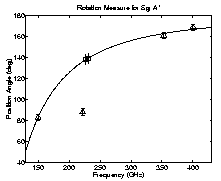
Interferometric Detection of Linear Polarization in Sagittarius A* at 230 GHz
Bower G.C.(1), Wright M.C.H.(2), Falcke H.(3), Backer D.C.(2)
(1) National Radio Astronomy Observatory, P.O. Box O, 1003 Lopezville, Socorro, NM 87801(2) Astronomy Department & Radio Astronomy Laboratory, University of California, Berkeley, CA 94720
(3) Max-Planck-Institut für Radioastronomie, Auf den Hüugel 69, D-53121 Bonn, Germany
The Astrophysical Journal (2002), submitted
Preprints: [PostScript, LaTex].Abstract:
We measured the linear polarization in Sagittarius A* to be 7.2 +/- 0.6% at 230 GHz using the BIMA array with a resolution of 3.6 * 0.9 arcsec. This confirms the previously reported detection with the JCMT 14-m antenna. Our high resolution observations demonstrate that the polarization does not arise from dust but from a synchrotron or cyclo-synchrotron source associated with Sgr A*. We see no change in the polarization position angle and only a small change in the polarization fraction in four observations over 60 days. We find a position angle 139 +/- 4 degrees which differs substantially from that found by the earlier JCMT observations at the same frequency. The BIMA observations alone place an upper limit on the magnitude of the rotation measure of 2* 10^6 \rdm. Combined with the JCMT observations at 150, 375 and 400 GHz, we measure RM=-4.3 +/- 0.1 * 10^5. This RM may be caused by an external Faraday screen. Barring a special geometry or a high number of field reversals, this RM rules out accretion rates greater than ~ 10^-7 M_sun/yr. This is inconsistent with high accretion rates as used in standard advection dominated accretion flow and Bondi-Hoyle models for Sgr A*. It argues for low accretion rates as a major factor in the overall faintness of Sgr A*.
Paper: Available in PostScript and (AAS)LaTex.
Other publications can be found here.
Questions: Heino Falcke, hfalcke@mpifr-bonn.mpg.de